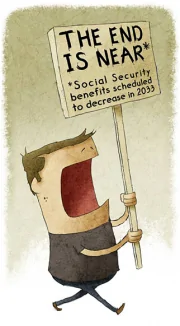Planning for retirement includes assuming that Social Security might not be able to cover all of your expenses. — but you should know that the benefits program probably won’t disappear either.
 The money that is paid out to most Social Security beneficiaries primarily comes from taxes on current workers, rather than that diminishing pool of assets.
The money that is paid out to most Social Security beneficiaries primarily comes from taxes on current workers, rather than that diminishing pool of assets.
The Social Security Administration (SSA) projects that Social Security will not be able to pay out full benefits starting in the year 2034.
However, it’s unclear whether at that point there won’t be enough workers paying Social Security taxes to cover all the benefits of the people who are supposed to receive them.
More and more people are becoming aware of Social Security’s problems. In fact, in a survey by Bankrate, nearly 25% of respondents said they do not expect to receive anything from Social Security.
Future Benefits Are Uncertain
There is a lot of uncertainty surrounding how much we might receive in Social Security benefits when we retire.
This makes retirement planning more difficult since projecting retirement income is a very large part of any retirement plan.
It is so important in retirement to try and get income above one’s expenses. This is the best way to ensure that you will never run out of money in retirement.
Prepare for Uncertainty
With interest rates still very low by historical standards, you must think like a good financial advisor and look for great dividend-paying stocks.
Some of the most solid companies out there, such as Wal-Mart, Procter & Gamble, and Johnson & Johnson have never cut their dividends, even in major recessions.
Stocks like these can provide stable income throughout retirement and can help make sure that income covers retirement expenses.
Not only do great dividend payers provide a stream of income in retirement, but their prices have been shown to be less volatile than the overall market.
It’s also important to assume that your Social Security benefits will likely be reduced by at least 10%.
Run some scenarios in a good financial planning application where Social Security is reduced by 5%, 10%, all the way through 25% to see how your plan holds up.
In this way, you can see just how susceptible you are to changes in your benefits.
Readers, what are your expectations for Social Security benefits in retirement?
Read More About Retirement Planning
- Get a Financial Life in Retirement
- Do You Think Retirement Is Out of the Question? Think Again!
- How To Remain Active and Generate Regular Income After Retirement
- 5 Common Retirement Money Wasters
- How To Save for an Early Retirement
- Review, Rewind, and Repeat: How to Keep a Close Eye on That Retirement Plan
- Retirement Planning Means Life Planning

